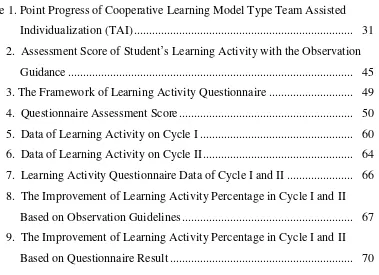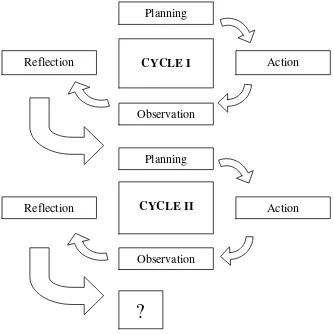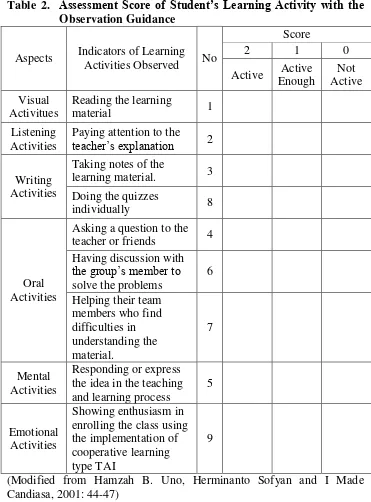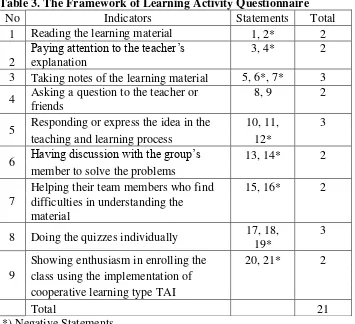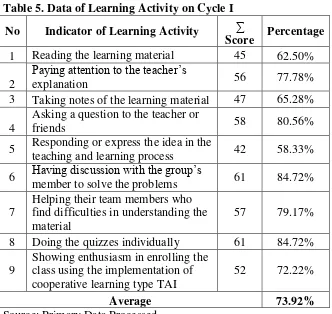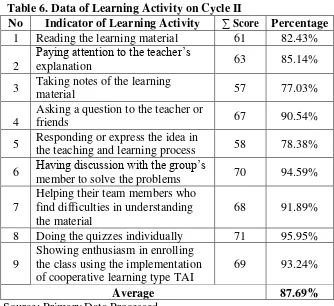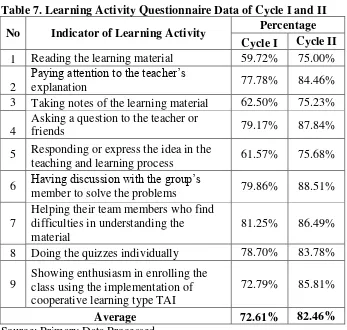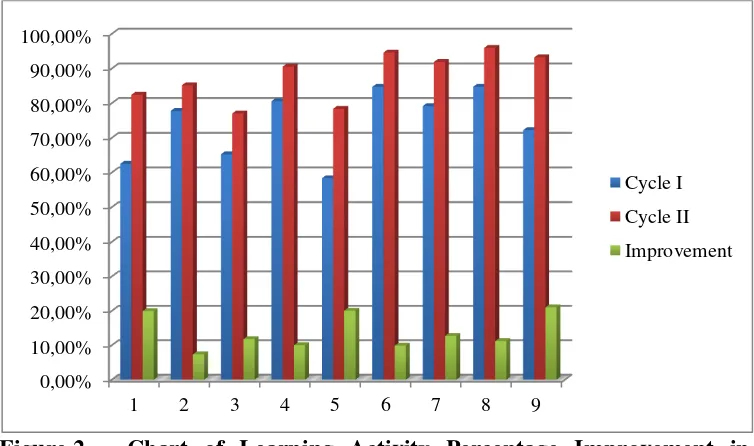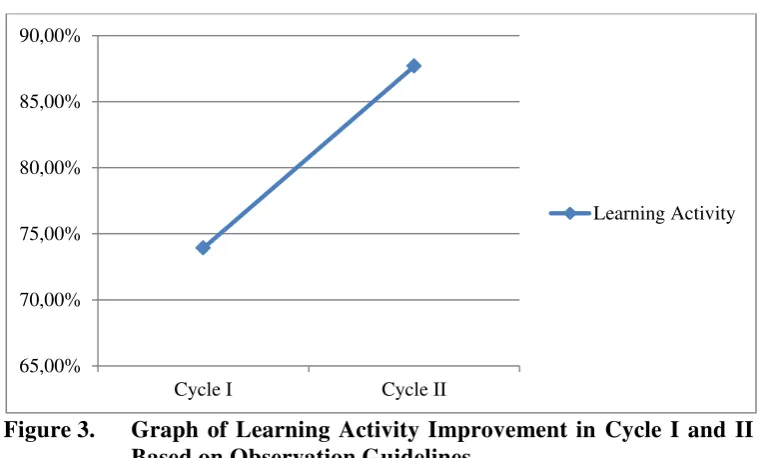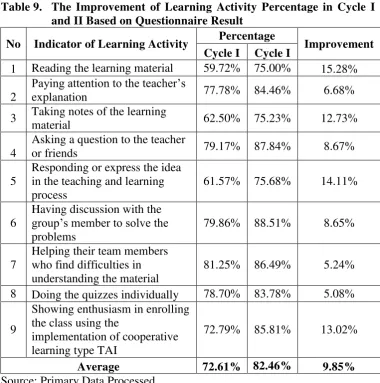THE IMPLEMENTATION OF COOPERATIVE LEARNING MODEL TYPE TEAM ASSISTED INDIVIDUALIZATION (TAI) TO IMPROVE STUDENT’S ACCOUNTING LEARNING ACTIVITY
OF GRADE X AK 3 AT SMK NEGERI 1 KLATEN ACADEMIC YEAR OF 2013/2014
UNDERGRADUATE THESIS
This undergraduate thesis is submitted in partial fulfillment of the requirements to obtain the degree of Bachelor of Education in Faculty of Economics
Yogyakarta State University
By:
FITROH KUSUMAYANTI 10418244002
ACCOUNTING EDUCATION STUDY PROGRAM ACCOUNTING EDUCATION DEPARTMENT
FACULTY OF ECONOMICS YOGYAKARTA STATE UNIVERSITY
i
THE IMPLEMENTATION OF COOPERATIVE LEARNING MODEL TYPE TEAM ASSISTED INDIVIDUALIZATION (TAI) TO
IMPROVE STUDENT’S ACCOUNTING LEARNING ACTIVITY OF GRADE X AK 3 AT SMK NEGERI 1 KLATEN
ACADEMIC YEAR OF 2013/2014
UNDERGRADUATE THESIS
This undergraduate thesis is submitted in partial fulfillment of the requirements to obtain the degree of Bachelor of Education in Faculty of Economics
Yogyakarta State University
By:
FITROH KUSUMAYANTI 10418244002
ACCOUNTING EDUCATION STUDY PROGRAM ACCOUNTING EDUCATION DEPARTMENT
FACULTY OF ECONOMICS YOGYAKARTA STATE UNIVERSITY
v MOTTO
“Dan barangsiapa yang bertakwa kepada
Allah niscaya Allah menjadikan baginya kemudahan dalam urusannya”
(Q.S. Ath-Thalaaq: 4)
“Jangan pikirkan kegagalan kemarin, hari ini sudah lain, sukses pasti di raih selama semangat masih menyengat”
(Mario Teguh)
“Allah itu Maha Baik, jadi yakinlah Dia akan selalu memberikan yang terBaik”
(Fitroh Kusumayanti)
DEDICATION
With thanks to Allah SWT., my simple paper is dedicated to:
1. My Mom and Dad who are always with me in prayer and love. You still the best, Dad. May Allah give the best place for you.
vi
IMPLEMENTASI MODEL COOPERATIVE LEARNING TIPE TEAM ASSISTED INDIVIDUALIZATION (TAI) UNTUK MENINGKATKAN
AKTIVITAS BELAJAR AKUNTANSI SISWA KELAS X AK 3 SMK NEGERI 1 KLATEN TAHUN AJARAN 2013/2014
Oleh:
FitrohKusumayanti 10418244002
ABSTRAK
Penelitian ini bertujuan untuk meningkatkan aktivitas belajar akuntansi siswa kelas X Ak 3 SMK Negeri 1 Klaten tahun ajaran 2013/2014 dengan mengimplementasikan model cooperative learning tipe Team Assisted Individualization (TAI).
Penelitian ini merupakan Penelitian Tindakan Kelas (PTK) yang dilakukan secara kolaboratif dan dilaksanakan dalam dua siklus dimana setiap siklusnya memiliki empat tahap yaitu: (1) perencanaan (planning), (2) tindakan/pelaksanaan (action), (3) pengamatan (observation), dan (4) refleksi (reflection). Teknik pengumpulan data yang digunakan dalam penelitian ini adalah observasi partisipasi, angket, dan dokumentasi. Analisis data yang digunakan adalah analisis kualitatif dan analisis kuantitatif. Analisis kualitatif dilakukan dengan mereduksi data, memaparkan data, dan menarik kesimpulan. Sedangkan analisis kuantitatif dilakukan dengan membandingkan perolehan skor aktivitas belajar akuntansi dengan skor maksimum yang kemudian dipersentasekan. Kriteria keberhasilan penelitian ini ditandai dengan persentase aktivitas belajar secara keseluruhan mencapai 75% yang didasarkan pada ketercapaian masing-masing indikator aktivitas belajar siswa atau minimal 28 siswa yaitu 75% dari jumlah siswa secara keseluruhan yang mengalami peningkatan skor aktivitas belajar.
Hasil penelitian ini menunjukkan adanya peningkatan aktivitas belajar akuntansi siswa kelas X AK 3 SMK Negeri 1 Klaten tahun ajaran 2013/2014. Hal ini ditunjukkan dengan peningkatan skor aktivitas belajar akuntansi dari siklus I ke siklus II yang diperoleh dari data observasi dan angket. Data observasi menunjukkan peningkatan skor aktivitas belajar akuntansi sebesar 13,77% yaitu dari 73,92% pada siklus I menjadi 87,69% pada siklus II. Selain itu, data angket juga menunjukkan adanya peningkatan skor aktivitas belajar akuntansi sebesar 9,85% yaitu dari 72,61% pada siklus I menjadi 82,46% pada siklus II.
vii
THE IMPLEMENTATION OF COOPERATIVE LEARNING MODEL TYPE TEAM ASSISTED INDIVIDUALIZATION (TAI) TO IMPROVE STUDENT’S ACCOUNTING LEARNING ACTIVITY
OF GRADE X AK 3 AT SMK NEGERI 1 KLATEN
This research aimed to improve the student's accounting learning activity of grade X Ak 3 at SMK Negeri 1 Klaten academic year of 2013/2014 through the implementation of cooperative learning model type Team Assisted Individualization (TAI).
The type of this research is a Classroom Action Research (CAR) was done collaboratively and implemented in two cycles where each cycle has four stages: (1) planning, (2) action, (3) observation, and (4) reflection. The data collection technique in this study was done by participant observation, questionnaires, and documentation. While the data analysis technique used were qualitative data analysis and quantitative data analysis. Qualitative data analysis was done by reducing the data, describing the data, and draw conclusions. While the quantitative data analysis was done by comparing the score of accounting learning activity with the maximum score which then look for the percentage. The successful action criteria of this research was characterized by the percentage of overall learning activity which is 75% based on the achievement of each indicators of student's learning activity or at least 28 students ie 75% of the overall number of students who have an increase in the score of learning activity.
The results of this research showed an increase in the student's accounting learning activity of grade X Ak 3 SMK Negeri 1 Klaten academic year of 2013/2014. This is indicated by the increase in student's accounting learning activity from the first cycle to the second cycle obtained from the observation data and questionnaires. Observation data showed an increase in student's accounting learning activity for 13.77%, from 73.92% in the first cycle to 87.69% in the second cycle. In addition, the questionnaire data also showed an increase in the score of student's accounting learning activity for 9.85%, from 72.61% in the first cycle to 82.46% in the second cycle.
x
TABLE OF CONTENT
Page
COVER ... i
SUPERVISOR VALIDATION PAGE ... ii
VALIDATION PAGE ... iii
DECLARATION OF AUTHENTICITY ... iv
MOTTO AND DEDICATION ... v
B. Identification of the Problems ... 5
C. Problems Restriction ... 5
D. Problems Formulation ... 6
E. Objective of the Research ... 6
F. Significances of the Research ... 6
CHAPTER II LITERATURE REVIEW ... 9
A. Theoretical Review ... 9
1. Review of Accounting Learning Activity ... 9
a. The Understanding of Accounting Learning Activity ... 9
b. Types of Learning Activity ... 11
c. Factors that Affect Student’s Learning Activity ... 13
2. Review of Cooperative Learning Model Type Team Assisted Individualization (TAI) ... 15
a. Cooperative Learning Model ... 15
xi
2) The Characteristics of Cooperative Learning ... 16
3) The Elements of Cooperative Learning Model ... 19
4) Various Models of Cooperative Learning ... 21
5) The Procedures of Cooperative Learning ... 25
b. Cooperative Learning Model Type Team Assisted Individualization (TAI) ... 26
1) The Definition of Cooperative Learning Model Type Team Assisted Individualization (TAI)... 26
2) The Components of Cooperative Learning Model Type Team Assisted Individualization (TAI)... 28
3) The Procedures Cooperative Learning Model Type Team Assisted Individualization (TAI)... 29
4) Establishment and Team Recognition on Cooperative Learning Model Type Team Assisted Individualization (TAI) ... 30
5) The Advantages and Disadvantages of Cooperative Learning Model Type Team Assisted Individualization (TAI) ... 32
B. Relevant Researches... 33
C. Research Framework ... 36
D. Research Hypothesis ... 37
CHAPTER III RESEARCH METHOD ... 39
A. Research Type ... 39
B. Research Place and Time ... 39
C. Research Subject and Object ... 40
D. Operational Definition ... 41
E. Data Collection Techniques ... 42
F. Research Instruments ... 43
G. Research Procedures ... 50
H. Data Analysis Technique ... 52
I. Successful Action Criteria ... 53
CHAPTER IV RESEARCH RESULT AND DISCUSSION ... 55
xii
1. Overview of Research Place ... 55
2. Research Result ... 55
a. Research Result of Cycle I ... 56
b. Research Result of the Cycle II ... 62
c. Questionnaire Result of Cycle I and Cycle II ... 65
B. Discussion of Research Result ... 67
C. Research Weaknesses... 79
CHAPTER V CONCLUSION AND SUGGESTIONS ... 80
A. Conclusion ... 80
B. Suggestions ... 80
REFERENCES ... 82
xiii
LIST OF TABLE
Page Table 1. Point Progress of Cooperative Learning Model Type Team Assisted
Individualization (TAI) ... 31
2. Assessment Score of Student’s Learning Activity with the Observation Guidance ... 45
3. The Framework of Learning Activity Questionnaire ... 49
4. Questionnaire Assessment Score ... 50
5. Data of Learning Activity on Cycle I ... 60
6. Data of Learning Activity on Cycle II ... 64
7. Learning Activity Questionnaire Data of Cycle I and II ... 66
8. The Improvement of Learning Activity Percentage in Cycle I and II Based on Observation Guidelines ... 67
xiv
LIST OF FIGURE
Page Figure 1. The Design of Classroom Action Research Activity using Kemmis
and Taggart Model... 40 2. Chart of Learning Activity Percentage Improvement in Cycle I and II
Based on Observation Guidelines... 68 3. Graph of Learning Activity Improvement in Cycle I and II Based on
Observation Guidelines ... 69 4. Chart of Learning Activity Percentage Improvement in Cycle I and II
Based on Questionnaire Result ... 71 5. Chart of Learning Activity Improvement in Cycle I and II Based on
xv
LIST OF APPENDIX
Page
Appendix 1. Research Instruments ... 85
2. Lesson Plan (RPP), The Questions of Pre-Test, Post Test and Group’s Test, and Learning Module ... 92
3. List Student Presence and Team ... 133
4. Research Result of Cycle I ... 135
5. Research Result of Cycle II ... 145
6. Score of Pre-Test, Post Test and Group’s Test of Cycle I and Cycle II ... 153
7. Field Notes of Cycle I and Cycle II ... 159
1 A. Background of the Study
Education is one way to build a qualified human resource and give benefits for the local community. In its development, education has always experienced a renewal in order to find the structure of the curriculum, the education system, as well as the effective and efficient learning model. According to Undang-Undang No. 20 tahun 2003 about the National Education System:
Pendidikan adalah usaha sadar dan terencana untuk mewujudkan susana belajar dan proses pembelajaran agar peserta didik secara aktif mengembangkan potensi dirinya untuk memiliki kekuatan spiritual keagamaan, pengendalian diri, kepribadian, kecerdasan, akhlak mulia, serta keterampilan yang diperlukan dirinya, masyarakat, bangsa dan negara.
In relation to item (1) of pasal 40 Undang-Undang about the National Educational System, educators are obligated to create a meaningful education, fun, creative, and dynamic, so the learners are expected to be more active in enrolling the class. Therefore, the teachers as educators are required to choose a method that can improve student's learning activities.
implied the existence of an unity of activity that is inseparable between students teachers. In this case, the teacher should be a facilitator, motivator, and a series of other tasks so the teacher can make the students being actively involved in the learning process in order to achieved the learning objectives. Wina Sanjaya (2011: 99) states that students are not regarded as passive organisms that just as recipients of information, but they are seen as an active organism, which has the potential to developed. But in reality these conditions can not be achieved, because there is still a conventional learning.
all students actively improved both physically and socially in the learning process. Therefore, student’s learning activities need to be improved."
Lecturing method indeed can not be delinked but the teacher are required to develop her creativity in choosing and use the learning model that more involving students’ activity and create innovation, so the learning is fun. One of the learning models that can be implemented to improve the activity is a model of Cooperative Learning. Through cooperative learning, (1) students do not always depend on the teacher, but can improve their ability to think independently, (2) students can develop the ability to express ideas or opinion and comparing it to the ideas of others, (3) students will respect on friends and realize its limitations, (4) empower every students to be more responsible in learning, (5) improve performance and social academic ability including positive interpersonal relations with another people, (6) develop the students’
ability to test his ideas and concepts (7) improve students’ ability to use the abstract learning information to be more real and (8) the interaction that occur during the implementation of cooperative learning process can improve motivation and provide stimulus for thinking (Wina Sanjaya, 2009: 249-250).
One model of cooperative learning that can be used to improve student’s accounting learning activities is a learning model of TAI (Team
group of 4-5 students which are heterogeneous, and each student in the group work together to sharing their opinions and was responsible for the final outcome of the group. This learning model was implement a peer guidance, where the students who were have a high academic capability are responsible for the students with low academic capability. The implementation of this model is expected to improve the group's learning activities in addition to the individual learning activities. This is because each student in the group are actively interacting in exchange ideas, discuss, and work together to help each other overcome the problems to achieve success.
The implementation of cooperative learning model type Team Assisted Individualization (TAI) is requires the good cooperation between the accounting teachers with researchers through the Classroom Action Research (CAR). CAR has a very important and strategic role to improve the quality of learning when implemented properly and completely. This research process provides opportunities for researchers and accounting teachers to identify the learning problems at school, then can be further studied and completed. Thus, the accounting learning process in school by implementing the cooperative learning model type TAI is expected to improve student’s learning activities.
Assisted Individualization (TAI) to Improve Student’s Accounting Learning Activity of Grade X Ak 3 at SMK Negeri 1 Klaten Academic Year of 2013/2014”.
B. Identification of the Problems
Based on the background of study, the identified problems are:
1. Most of accounting learning at SMK Negeri 1 Klaten is still dominated by lecturing method (teacher oriented), so the student become passive and not enthustiastic to follow the learning process.
2. Student's accounting learning activity of Grade X Ak 3 is still low. 3. Students interaction in the learning activity is not optimal.
4. When the students given a task, only about 25% of students who are interested to present their answers in front of the class.
C. Problems Restriction
Based on the background of the study and identification of the problems above, the problems covered are complex. Therefore, there should be restrictions on the problem, so this research becomes more focused in solving the problems.
D. Problems Formulation
According to the identification of the problems and problems restriction above, the problems formulation of this research is “Can Cooperative Learning Model Type Team Assisted Individualization (TAI) Improve Student’s Learning Activity of Grade X Ak 3 at SMK Negeri 1
Klaten Academic Year of 2013/2014?”
E. Objective of the Research
The objective of this research is to improve student’s learning activity through the implementation of cooperative learning model type Team Assisted Individualization (TAI) of grade X Ak 3 at SMK Negeri 1 Klaten academic year of 2013/2014.
F. Significances of the Research
The research is expected to bring benefits: 1. Theoretical Significant
a. The results of this study is expected to be a source of information of education, especially about the implementation of cooperative learning model type Team Assisted Individualization (TAI) to improve student’s learning activity.
2. Practical Significant a. For the Researcher
The results of this study are expected to provide a new experience in applying cooperative learning model type Team Assisted Individualization (TAI).
b. For the Students
1) Improve student’s learning activity in the teaching and learning process.
2) Provides a more conducive and varied learning atmosphere, so the students are not monotonous in learning with conventional methods, and it is expected to give a positive impact student in student’s learning activities.
3) Train and guiding students to be dare to express their idea based on their understanding.
4) Train students to have a mutual cooperation with another students. c. For the Teacher
1) To develop the existing accounting learning material with the new innovation, to develop the teachers’ skill in teaching and get the proper learning strategy to improve student’s learning activity 2) Provide input in the development of accounting learning using
d. For The Decision Makers in School
1) This research can be used as a consideration and inputs to support their its efforts in improving teachers’ professionalism in conducting the teaching and learning process.
9 A. Theoretical Review
1. Review of Accounting Learning Activity
a. The Understanding of Accounting Learning Activity
Learning activity is any form of activities performed both at the school and outside the school that supports student’s learning activities. According to Anton M. Mulyono (2001: 26), activity means activity. So everything that occur either physical or non-physical is called activity. Students’ activity that occur during the teaching and learning process is one indicator of students’ desire to learn.
Basically, learning is doing, doing something to change behaviour. When there is no learning, there will be no activity so; activities are the essential basic principle in teaching and learning activities. In the learning process, the students must enrolling the class actively. Learning needs activities because without activities, learning processes will not run well. (Sardiman A.M., 2011: 95-97).
the environments that involve cognitive processes. (Muhibbin Syah, 2005: 92).
From some definitions above, it can be concluded that the student’s learning activity is an activity undertaken by students who
can bring positive change on the students because of the interaction between individuals and the individual with the environment.
James M. Reeve (2009: 9) defined accounting as an information system that provide reports to stakeholders about the economic activities and condition of a business.
Further, Hendi Somantri (2007: 19) explained that:
Dari sudut prosesnya atau dalam arti sempit, akuntansi adalah suatu proses yang meliputi: pencatatan, penggolongan, pengikhtisaran, dan pelaporan transaksi keuangan perusahaan yang terjadi dalam suatu periode tertentu. Sementara dalam ruang lingkup yang lebih luas, kegiatan akuntansi meliputi perencanaan sistem, analisis laporan keuangan, serta interpretasi (penafsiran) pengaruhnya terhadap kegiatan operasi perusahaan di masa datang.
According to Kimmel et al. (2011), accounting is an information system that identifies, records, and communicates the economic events of an organization to the stakeholders. From this definition, accounting can be defined as the process of identifying, recording and communicating the economic events of an organization to the stakeholders in the form of financial statement.
of financial statement that will be used for the decision making. So, accounting learning activity is the activity carried out by the students activities, eihter physically or non-physically, both at the school and outside the school, that supports student’s learning activities to gain a new experience or knowledge about accounting learning material through the interaction between an individual with the environtment. b. Types of Learning Activity
There are a lot of types of learning activity that can be done by the students in the classroom. Paul B. Diedrich in Sardiman A.M. (2011: 101) divides learning activities in 8 groups, they are:
1) Visual activities,yang termasuk di dalamnya misalnya, membaca, memperhatikan gambar demonstrasi, percobaan, pekerjaan orang lain.
2) Oral activities, seperti: menyatakan, merumuskan, bertanya, memberi saran, mengeluarkan pendapat, mengadakan wawancara, diskusi, dan interupsi.
3) Listening activities, sebagai contoh mendengarkan: uraian, percakapan, diskusi, musik, pidato.
4) Writing activities, seperti misalnya menulis cerita, karangan, laporan, angket, menyalin.
5) Drawing activities, misalnya: menggambar, membuat grafik, peta, diagram.
6) Motor activities, yang termasuk di dalamnya antara lain: melakukan percobaan, membuat konstruksi, model mereparasi, bermain, berkebun, beternak.
7) Mental activities, sebagai contoh misalnya: menanggapi, mengingat, memecahkan soal, menganalisis, melihat hubungan, mengambil keputusan.
8) Emotional activities, seperti misalnya, menaruh minat, merasa bosan, gembira, bersemangat, bergairah, berani, tenang, gugup.
complex and varied. It can be seen that learning activity is not only a physical activity, but also involving the mental and emotional. All of these learning activity will complete each other.
Types of learning activities by M. Dalyono (2009: 218-225) is divided into several indicators as follows:
1) Mendengarkan, 2) Memandang,
3) Meraba, membau, dan mencicipi/mengecap, 4) Menulis atau mencatat,
5) Membaca,
6) Membuat ikhtisar atau ringkasan dan menggarisbawahi, 7) Mengamati tabel-tabel, diagram-diagram dan
bagan-bagan,
8) Menyusun paper atau kertas kerja, 9) Mengingat,
10)Berfikir,
11)Latihan atau praktek.
Gagne and Briggs (Martinis, 2007: 84) state that there are some factors that can make the students active in teaching and learning process. They are:
1) Motivate or encourage the students, so that they can be active in teaching and learning process.
2) Explain the instructional goal (basic ability) to the students. 3) Remind the students about the learning competency.
4) Stimulate the students (problems, topic, and concepts that will be studied).
5) Give guidance to the students on how to study them.
7) Give feedback.
8) Do test to measure the ability of the students. 9) Conclude every materials in the end of the lesson. c. Factors that Affect Student’s Learning Activity
In general, factors that affect students activity according to Sumadi Suryabrata (2011: 233-237) consist of two parts, they are internal factors and external factors.
1) Internal Factors
Internal factors are all aspects contained in the students individually, such as physiological aspects as well as psychological aspects.
a) Physiological Aspects
This factor can be divided into two condition: (1) Physical Condition
A healthy physical condition will certainly affect the learning activities undertaken by students. A healthy physical condition will certainly different from the unwell physical condition.
(2) Condition of the Senses Function
Senses is a tool that is able to capture stimulus to immediately be processed inside student’s self personally.
b) Psychological Aspects
Sardiman A.M. (2012: 45) point out that there are at least eight psychological factors that affects someone to do the activity of learning. The factors are attention, observation, responses, fantasy, memories, thinking, talent, and motives. 2) External Factors
Sumadi Suryabrata (2011: 233) stated that external factors are classified into two groups, namely: non-social factors and social factors.
a) Non-social Factors in Learning
Non-social factors in learning are: air temperature, weather, time, place, tools that used by the students, buildings, etc.
b) Social Factors in Learning
environment that more affecting student’s learning activities are parents and family.
2. Review of Cooperative Learning Model Type Team Assisted Individualization (TAI)
a. Cooperative Learning Model
1) The Understanding of Cooperative Learning Model
The Learning Model is a pattern used as a guideline in planning the learning in the classroom as well as tutorials. Agus Suprijono (2010: 46), stated that there are three learning models that can be used in manage the learning process, they are: (a) direct learning model; (b) cooperative learning model; and (c) problem-based learning model. Through the model of learning, the teacher could help students to get the information, ideas, skill, ways of thinking, and expressing their idea. A model of learning can be used as a guideline for teachers in planning the activity of teaching and learning.
Wina Sanjaya (2011: 242) explained that:
Pembelajaran kooperatif merupakan model pembelajaran dengan menggunakan sistem pengelompokan/tim kecil, yaitu antara empat sampai enam orang yang mempunyai latar belakang kemampuan akademik, jenis kelamin, ras atau suku yang berbeda (heterogen). Sistem penilaian dilakukan secara kelompok. Setiap kelompok akan memperoleh penghargaan (reward) jika kelompok mampu menunjukkan prestasi yang dipersyaratkan.
Anita Lie (2008: 12) also argued that the cooperative learning is a teaching system which gives the opportunity to students to cooperate with fellow students in structured tasks. In the cooperative classroom, students are expected to help each other, mutually discuss and argue to sharpening their knowledge and close the gaps of each ability to understand the learning material.
From the understanding of cooperative learning according to the experts above, it can be concluded that cooperative learning is a learning model that puts their students in small groups with diverse backgrounds and expected the students to be capable in interacting and cooperating in a group to achieve a common goal. 2) The Characteristics of Cooperative Learning
a) Team-based-learning
Cooperative learning is team-based-learning. Team is used as a media to reach the goal. For that reason, team should make every members learn. Every members must help each other to reach the goal. The success of the learning is determined by the success of the team. Every team is set as heterogenic to make the students get experience from others, give and accept others, so every students will give contribution for the success of the team.
b) Cooperative-management based
c) Willingness to cooperate
The success of cooperative learning is determined by the success of the group or team. So, the principle of cooperation have to be encouraged in cooperative learning process.
d) Cooperation skill
The willingness to cooperate then is practiced through the activity which is showed in cooperation skill. Thereby, students need to be encouraged to be able to interact and communicate with another members. The students should be helped to face the obstruction in interacting and communicating, so that they can express their idea, express their opinion, and give contribution on the success of the group.
Arends (in Trianto, 2010: 65-66) stated that learning stated that learning that uses cooperative learning has the following characteristics:
a) Students work in groups cooperatively to complete learning materials.
b) Group was formed from the students who have the capability of high, medium, and low.
d) The awards are more oriented to the group rather than the individual.
3) The Elements of Cooperative Learning Model
Roger and David Johnson (in Anita Lie 2008: 14) stated that not all kinds of group work can be considered as cooperative learning model. To achive the maximum results, there are five elements of cooperative learning model that must be implemented, the elements are: (a) positive interdependence, (b) individual responsibility, (c) face to face, (d) communication between members, (e) evaluation of group process.
Positive interdependence means that the success of the group is very depends on the efforts of each members. To create an effective working group, the tasks need to be arranged to make each member of the group finish their work by themselves in order to achieve their goals.
Responsibility is the direct element of the positive interdependence element, as it has been explained, in cooperative learning, the group's success is determined by the efforts of every member of the group. If they want to be the best group, the members should be responsible for learning seriously and trying to get the best score.
group know each other. This not only as names recognition, but the most important thing is to know the advantages and disadvantages of each member. Thus, it will awaken an atmosphere of mutual respect differences and capitalize on strengths and fill the shortfall.
Communication between members means any group members communicate and interact each other. The communication is intertwined from many direction, meaning that there is reciprocity between group members. Generally, not every student is good at communicating. Therefore, it is important for teachers to train students the ways of communicating. For example the way to express an idea, refute the opinions of friends and respond to the friend’s opinions.
Align with the opinion above, Harsono and Dwiyanto (2005: 17) stated that to achive the maximum results, there are five elements of cooperative learning model that must be implemented, the elements are positive interdependence, individual responsibility, face to face, communication between members, and evaluation of group process.
4) Various Models of Cooperative Learning
There are some variations in the types of cooperative learning models developed by educational experts and practitioners, especially by the experts of Student Team Learning at Johns Hopkins University in Slavin (2009: 11), but only about ten types that get a widespread attention, namely:
a) Learning Together
In this type of cooperative learning model, the teacher divides the students into small groups heterogeneously. Each group worked together to complete the tasks assigned by the teacher. One group is only received and did a set of assignments sheets. Assessment is based on the result of the group work.
b) Teams-Games-Tournament (TGT)
is one type or model of cooperative learning that involving the students as peers and contains elements of role play and reinforcement.
c) Group Investigation (GI)
Is the most complex and the most difficult model of cooperative learning to implement. This approach requires the norm and class structure which is more complicated than an approach that centered to the teacher. In its implementation, the teacher divides the class into groups of 5-6 students with heterogeneous members. The group can be formed by considering the familiarity of friendship or a similar interest in a particular topic. Furthermore, students choose a topic that will be investigated, and conduct a thorough investigation over the selected topic. Furthermore, they prepares and presented their report to the entire class.
d) Academic-Constructive Controversy (AC)
Assessment is done based on the ability of the member or group in maintaining their position that have been chosen. e) Jigsaw Procedure (JP)
Basically, in this model the teacher split large units of information into smaller components. The teacher divides students into cooperative learning groups consisting of four students, so each member is responsible to mastered each component or sub-topics assigned by the teacher, as well as possible. Students from each group who is responsible on the same subtopic with another then make a group again that consisting of two or three people.
f) Student Teams Achievement Division (STAD)
This is a type of cooperative learning using small groups with a total membership of each group of 4-5 students heterogeneously. Beginning with the delivery of learning objectives, delivering the learning material, group activities, quizzes, and give an award to the best group. Its focus is on the success of a student that will be affected the success of the group, as well as the success of the group will affected the success of students individually.
g) Complex Instruction (CI)
particularly in the fields of science, mathematics, and social sciences. Its focus is to develop the interest of all members of the group about a particular subject. This type is generally used in the billingual learning and among the students who are very heterogeneous. This research was based on the processes and outcomes of the group's work.
h) Team Assisted Individualization (TAI)
Is a combination of cooperative or collaborative learning with the individual learning. Gradually, each member of the group was given an exercise that they have to do individually first. After that, did the assessment in a group. If the question of the first phase has been completed correctly, each student have to do the next stage. However, if a student is not able to resolve the problem correctly in the first stage, he still had to resolve another problem at the same stage. Each stage of exercise are arranged by the difficulty level of question. Assessment is done based on individual and group learning outcomes.
i) Cooperative Learning Structures (CLS)
have been determined previously. During the intervening period has also been established earlier, the two students who were paired are have to switch roles each other.
j) Cooperative Integrated Reading and Composition (CIRC) This type of learning model is similar to TAI. As its name, this study is emphasizes on the learning of reading, writing, and grammar. In this study, the students are assessed each student's ability in reading, writing, and grammar, both written and oral in their group.
5) The Procedures of Cooperative Learning
The procedures of cooperative learning according to Rusman (2010: 212-213) consist of four stages, namely:
a) Explanation of Learning Material. This stage is the stage of delivering the basic knowledge of the learning material before the students learn in groups. The purpose of this step is to make the student understand the learning material.
b) Learning in groups. This step is done after the teacher gives a description of the material, students work in groups which have been formed before.
while the group will give an assessment on the ability of his group.
d) The Team Recognition. Is the judgement to get the most prominent or the most high achieving team, and then they will received an reward, in hopes can motivate the team to keep doing better again.
b. Cooperative Learning Model Type Team Assisted Individualization (TAI)
1) The Definition of Cooperative Learning Model Type Team Assisted Individualization (TAI)
Classroom are divided into small groups to work together in achieving the learning objectives. Previously, each student has been given a subject matter by the teacher to be studied individually. Furthermore, the students joined into the group to learn together, to discuss the subject matter that has been studied individually, and match the answers about the questions that had been given by the teacher. It can increase an individual's understanding of the subject matter, cooperation, and have a responsibility for individual and group.
experience to learn the subject matter, so the students will have a meaningful learning.
2) The Components of Cooperative Learning Model Type Team Assisted Individualization (TAI)
TAI learning model has eight components (Slavin, 2005: 195-200). The eight components are as follows:
a) Teams, namely the formation of a heterogeneous group consisting of 4-5 students.
b) Placement test, by giving a pre-test to students or look at the average score of students so the teachers know the weaknesses of students in a particular field.
c) Curiculum materials, the students work individually on curriculum materials.
d) Team study, are the stages of learning actions that will be implemented by the teachers and the group of students who need a help.
e) Team scores and teams recognition, is a scoring or appreciation of the group's work in completing the task. f) Teaching group, is giving a learning material briefly from the
teacher before giving the task.
h) Whole-class units, is giving a learning material by the teacher at the end of learning process with problem-solving strategies. 3) The Procedures Cooperative Learning Model Type Team
Assisted Individualization (TAI)
Cooperative learning model type Team Assisted Individualization (TAI) is done in a series of actions in one cycle. Widyantini (2006: 12) explains that this type of learning can be done through the following procedures:
a) Teachers give assignments to students to study the learning materials that have been prepared, individually.
b) The teacher gave a quiz individually to students to get a base score or initial score.
c) The teacher divide students into groups. Each group consists of 4-5 students with different abilities. If it is possible, the members of the group come from different races, cultures, ethnic and gender.
d) Student's individual learning outcomes are discussed in the group. In the group discussions, each member of each group is checking the answers of their friends in their group.
e) The teacher facilitates the students in making a summary, directing, and giving reinforcement on learning materials that have been studied.
g) The teacher gave an award to the group based on the acquisition score of the increase in individual learning outcomes from the initial score to the next score of the quiz (latest).
4) Establishment and Team Recognition on Cooperative Learning Model Type Team Assisted Individualization (TAI)
Cooperative learning type Team Assisted Individualization (TAI) is identical to the heterogeneous division of the groups. This group is focused on the differences based on the level of academic distinction. The group differences meant that the students are complementary deficiencies of each individual. Students who have a good academic level are expected to provide an information for students who have low academic level.
The assessment consists of individual and team scores. Students will earn points if the progress of the quiz scores (post-test) is excess the initial score (pre-(post-test) obtained previously at the beginning of each cycle for each individual.
a) Determines the basic score of each student. The basic score can be either score of pre-test or use the score of previous examination.
b) Determine the score of the quiz that has been implemented after the students work in groups, for example, the score of the quiz I, quiz II, or the average score of quiz I and II quiz to every student that we refer to the score of the current quiz. c) Determines the score of an increase in the learning results
based on the difference in the score of the current quiz and basic score of each student using the following criteria:
Table 1. Point Progress of Cooperative Learning Model Type Team Assisted Individualization (TAI)
Quiz Score Progress
Point
More than 10 point below starting score 5
10-1 point under starting score 10
Starting score until 10 point above starting score 20 More than 10 point above starting score 30 Perfect answer sheet score (not based on starting score) 30 (Source: Slavin, 2009: 159)
Group Awards are given based on the average score of the improvements obtained by each group by giving a predicate of enough, good, very good, and perfect.
The criteria for the status of the Group:
a) Enough, when the average score of an increase in Group < 15. b) Good, when the average score of the increase in the group
c) Very good, when the average score of the increase in the group between 20 to < 25.
d) Perfect, when the average score of an increase in group25. 5) The Advantages and Disadvantages of Cooperative Learning
Model Type Team Assisted Individualization (TAI)
Each type of learning has some advantages and disadvantages. Some of the advantages of TAI are:
a) Students who have high academic ability are responsible to assist students who have low academic ability in his group. Thus, students who have high academic ability can develop their abilities and skills.
b) Students who have low academic ability will be assisted in understanding the learning material.
c) There is no competition among the students because students work together to solve problems in dealing with a different way of thinking.
d) Students are not only expect help from teachers, but students are also motivated to learn quickly and accurately on the whole learning material.
e) Teachers at least only use half of teaching time so it will be easier in the provision of individual assistance.
a) Students who have low academic ability will indirectly depends on students who have high academic ability.
b) There is no competition between groups.
c) Some of the members of the group are passive and do not want to try to be active, they just rely on their friends in group. d) If the classroom management that is done by the teacher is not
good, the learning process is also not going well.
e) If this model is a new learning model that is already known, the students may be feel confused, some of them was lost their self-confidence, and the other were disturbing their friends in group.
B. Relevant Researches
1. Research conducted by Ika Budiarti (2013) which is entitled “Implementasi Model Cooperative Learning Tipe TAI (Team Accelerated
Instruction) dalam Peningkatan Aktivitas dan Hasil Belajar Siswa pada
Kompetensi Dasar Menyusun Laporan Keuangan Perusahaan Jasa pada
Siswa Kelas X Ak 4 Program Keahlian Akuntansi SMK YPKK 2 Sleman
Tahun Ajaran 2012/2013”. The results of this research showed an
by 18.69% from 73.72% to 92.41%. In addition, the increase also occurred in the percentage of student's learning activities from 55.00% in the first cycle to 78.20% in the second cycle. The similarity of research conducted by Ika Budarti with this research lies in the learning model that is used and the subject of research, namely accounting learning activities. But besides accounting learning activity, Ika Budiarti also took subject of accounting learning outcomes. While the difference lies in the object, time, and place of study.
2. Research conducted by Dian Ayu Larasati (2013) entitled “Implementasi Model Pembelajaran Kooperatif Tipe Team Accelerated Instruction (TAI)
untuk Meningkatkan Interaksi Belajar Akuntansi Siswa Kelas X AK 1
SMK Batik Perbaik Purworejo Tahun Ajaran 2012/2013”. The results of
this research showed an increase in student's accounting learning interaction from 69.94% in the first cycle to 84.05% in the second cycle. The improvement of student's accounting learning interaction is 14.11%. The similarity of this research with the research conducted by Dian Ayu Larasati is the learning model that is used. While the difference is on the subject, object, time, and place of study.
3. Research conducted by Nuansa Ayu Febrina (2012) entitled “Peningkatan Aktivitas Belajar Akuntansi melalui Implementasi Model Pembelajaran
Kooperatif Tipe Student Teams Achievement Divisions (STAD) pada
Siswa Kelas X Akuntansi 3 Program Keahlian Akuntansi SMK Batik
there is an increase in all of the indicators of accounting learning activity, from cycle I to cycle II of 16.88% from 73.89% in the first cycle to 90.77% in the second cycle. The similarity between the research conducted by Nuansa Ayu Febriana with this research lies in the research subject, namely the accounting learning activity. While the difference is located on an object, the learning model that is used, time, and place of study.
4. Research conducted by Herlina Permatasari (2012) entitled “Penerapan Model Pembelajaran Kooperatif Tipe TAI (Team Assisted
Individualization) untuk Meningkatkan Hasil Belajar Akuntansi Siswa
Kelas XI Ak 1 SMK Abdi Negara Muntilan Tahun Ajaran 2012/2013”.
affective and psychomotor domains with the classical average of 90.56%. The similarity of the research conducted by Herlina Permatasari with this research lies in the learning model that is used. While the difference lies in the subject, object, time, and place of study.
C. Research Framework
The learning process in the classroom is a very important effort to help students in achieving the learning goals maximally. Based on the background of the problem, it is known that the accounting learning activity in grade X Ak 3 is still low. It was proven by the fact that most of the students in grade X Ak 3 do not pay attention to the teacher's explanation. When given a task, only about 25% of students who are interested to present their answers in front of the class. The lack of variation in the learning models that provides opportunities for students to work together in a group also makes students' interaction in the learning activity has not optimal.
student’s learning activity is the things to be noticed in order to construct their knowledge, while the teacher is only as a facilitator.
Responding to this situation, one of the efforts used in the learning is by developing learning which emphasizes on the social interaction of students in the classroom. One of the active and interactive learning models are cooperative learning model type Team Assisted Individualization (TAI) because it involves all students to take an active role in the form of group consisting of 4-5 students. This learning model combines the advantages of cooperative learning and individual learning which is designed to overcome the student's learning difficulties, individually. This learning model is implementing a peer guidance, where the students with high academic capability are responsible for the low academic capability. Learning is based on group collaboration, in which each individual have the same responsibilities to achieve group's goals. The group discussion will create an educational interaction where the students are actively involved in exchange their ideas, held a discussion, and work together to help each other in solving the problems to achieve their success. After the implementation of cooperative learning models type Team Assisted Individualization (TAI), the student's accounting learning activity is expected to increase.
D. Research Hypothesis
Model Type Team Assisted Individualization (TAI) is able to Improve Student’s Accounting Learning Activity of Grade X Ak 3 SMK Negeri 1
39 A. Research Type
The type of this research is Classroom Action Research (CAR). This classroom action research is done collaboratively and participatory. Teacher and researcher make a planning together, then the teacher acts as the party who did the action, while the researcher as an observer and take a note, then analyzed the data that was obtained (Suharsimi Arikunto, 2009: 17).
There are some experts who proposed a classroom action research model with a different chart, but generally there are four stages that have been through, namely: (1) Planning, (2) Action/Implementation, (3) Observation, and (4) Reflection. This CAR used the design developed by Kemmis and Taggart that will be conducted in two cycles. Each cycles consists of four stages, that are planning, action, observation, and reflection on the first cycle and will take the same phases at the second cycle. The design of Classroom action research used in this research can be seen in Figure 1.
B. Research Place and Time
Figure 1. The Design of Classroom Action Research Activity using Kemmis and Taggart Model (Suharsimi Arikunto, 2009: 16).
A. Research Subject and Object
The subject of this research were 37 students of grade X Ak 3 SMK Negeri 1 Klaten academic year of 2013/2014. While the object of the research was student’s accounting learning activity of the grade X Ak 3 SMK Negeri 1
Klaten academic year of 2013/2014.
Reflection Action
Observation
Reflection CYCLE II Action
Observation CYCLE I
?
B. Operational Definition
1. Accounting Learning Activity
Accounting learning activity is the activity carried out by the students activities, eihter physically or non-physically, both at the school and outside the school, that supports students’ learning activities to gain a
new experience or knowledge about accounting learning material through the interaction between an individual with the environtment.
The accounting learning activity can be measured through seven aspects, namely:
a. Visual activities indicated by the activity of reading the learning material
b. Oral activities indicated by the activities of asking a question about material to the teacher or friends, having discussion with the group’s member to solve the problems, and help their team members who find difficulties in understanding the material.
c. Listening activities indicated by the activity of listening or aying attention to the teacher’s explanation.
d. Writing activities indicated by the activities of taking notes of the learning material and do the assignments or quizzes.
f. Mental activities indicated by the activity of respond or express the idea in the teaching and learning process.
g. Emotional activities indicated by the students’ enthusiasm in enrolling the class using the implementation of cooperative learning model type Team Assistedindividualization (TAI).
2. Cooperative Learning Model Type Team Assisted Individualization (TAI) Cooperative learning model type Team Assisted individualization (TAI) is a learning model that combines the advantages of cooperative learning and individual learning which is designed to overcome the student's learning difficulties, individually, by implementing a peer guidance, where the students with high academic capability are responsible for the low academic capability.
C. Data Collection Techniques
1.
Participant Observation2. Questionnaire
Questionnaire is the data collection technique done by giving a set of questions or written statement to the respondent to be answered. Questionnaire will be the most efficient data collection techniques if researcher knows the variables that will be measured and know what could be expected from the respondent certainly. Questionnaire is a technique of collecting data through the forms containing written questions by a person or a group of people to get an answer or response and information required by researchers (Mardalis, 2008: 66).
3. Documentation
Documentation used as an amplifier for the data that obtained during the observation activities. The documentation in this research used the form of data of the number of students, fieldnotes, photographs of the learning activities, the syllabus, lesson plan, and others.
D. Research Instruments 1. Observation Guidance
Observation guidance of student’s learning activity is containing
Table 2. Assessment Score of Student’s Learning Activity with the Observation Guidance
Aspects Indicators of Learning Activities Observed No
Score
Asking a question to the teacher or friends 4 the idea in the teaching and learning process
The detailer scoring procedures are explained below: 1) Reading the learning material.
1: The student just read the learning material after the order from the teacher.
0: The student did not reads the learning material in the learning process.
2) Paying attention to the teacher’s explanation.
2: The student always pay attention for the teacher’s explaination. 1: The student pay attention for the teacher’s explanation but they also
chatting outside the material once.
0: The student did not pay attention to the teacher’s explanation. 3) Taking notes of the learning material.
2: The student always take a not of the whole learning material that is needed.
1: The student take a note of the learning material only when they were ordered by the teacher.
0: The student did not take a note of learning material from the beginning until the end of learning process.
4) Asking a question to the teacher or friends.
2: The student always ask a question about material or just clarified the learning material that they have been understood either to the teacher or to the friend.
0: The students did not ask any question from the beginning until the end of learning process.
5) Responding or express the idea in the teaching and learning process. 2: The students are actively respond or express their idea in the
teaching and learning process.
1: The students only respond or express their idea when they were ordered by the teacher.
0: The students did not give any feed back during the learning process 6) Having discussion with the group’s member to solve the problems.
2: The students are actively discussing with the group’s member to solve the problems.
1: The students only did the discussion with certain friend in its group to solve the problem
0: The students did not have any discussion with the group’s member to solve the problems.
7) Helping their team members who find difficulties in understanding the material.
2: The students were helping each other with the group’s member to undertand the learning material.
1: The students helps their group’s member to understand the learning material only when they were asked.
8) Doing the quizzes individually.
2: The students did the quizzes individually and confidently.
1: The students do the quizzes by themselves but sometimes asking for the friend’s answer.
0: The students did the quizzes by cheating on the friend’s answer. 9) Showing enthusiasm in enrolling the class using the implementation
of cooperative learning type TAI.
2: The students shows their enthusiasm and actively participated in enrolling the class using the implementation of cooperative learning type TAI.
1: The students were participated in enrolling the class using the implementation of cooperative learning type TAI just because they were ordered by the teacher.
0: The students did not actively participated in enrolling the class using the implementation of cooperative learning type TAI just because they were ordered by the teacher.
2. Questionnaire
the respondent. The questionnaire will be modified with three alternative answers, so the respondents were only five a check list (√) in a column of
answers that have been provided. The measurement of these variables by using the alternative answers provided, namely:
a. Always, if the statements are in accordance or always done by respondents.
b. Sometimes, if the statements sometimes done by respondents. c. Never, if the statements were did not done by the respondents. Table 3. The Framework of Learning Activity Questionnaire
No Indicators Statements Total
1 Reading the learning material 1, 2* 2
2
Paying attention to the teacher’s explanation
3, 4* 2
3 Taking notes of the learning material 5, 6*, 7* 3 4 Asking a question to the teacher or
friends
8 Doing the quizzes individually 17, 18, 19*
3
9
Showing enthusiasm in enrolling the 20, 21* 2
class using the implementation of
cooperative learning type TAI
Total 21
The assessment of questionnaire results can be seen in table 8. Table 4. Questionnaire Assessment Score
Positive Statements Negative Statements Score
Always Never 2
Sometimes Sometimes 1
Never Always 0
3. Field Notes
Field notes is a form used as a note to take the news events during the accounting learning process. Field notes contains various events that occur in the classroom. These events can be the interaction between students with the teacher and with the students.
E. Research Procedures
This research was carried out in two cycle that consists of four stages. According to Suharsimi Arikunto (2009:16), the four stages including: planning, action, observation, and reflection. The classroom action research procedures that will be implemented can be described as follows:
1. Cycle I a. Planning
prepare learning material, prepare the quizzes and its answer, setting up observation sheets, and prepare the field notes.
b. Action
Action stage is the implementation of the planning stage, or can be said as the implementation of cooperative learning model type Team Assisted Individualization (TAI). In this stage, teacher taught the students using the lesson plan have been made before.
c. Observation
At this stage, the activities performed were can not separated from the action stage, because the observations were made during the action stage. The researchers observed how was the process of teaching and learning carried out. Researcher and observer were observe the student’s learning activity in order to gain the data about learning activity in this stage.
d. Reflection
2. Cycle II
The implementation of cycle II was not too different from the implementation of cycle I. The four stages that will be implemented are palnning, action, observation, and reflection. In the implementation of cycle II were did the improvements according the reflection result of cycle I. This activity was carried out with the purpose of improving teaching practices in the first cycle in order to achieve the successful action criteria.
F. Data Analysis Technique
Data analysis techniques used in this research was conducted on contionusly during the data collection process until the end of the research or the conclusion formulation. This research was conducted in two forms of data analysis techniques, namely qualitative and quantitative data analysis technique.
1. Qualitative Data Analysis Technique
Qualitative data analysis is used when the empirical data is qualitative in the form of words and can not be categorized (Silalahi, 2006: 311). The activities of qualitative data analysis of this research are: a. Data Reduction
b. Data Presentation
In this research, the data related to the percentage of learning activities improvement that successfully achieved by researcher will be presented in the form of diagrams, whereas other data will be presented in the form of descriptions and tables.
c. Conclusion Formulation
The conclusion formulation is the process of capturing the essence of data that has been organized in the form of statement and/or formula. The conclusions obtained will answers some of the research question.
2. Quantitative Data Analysis Technique
This data analysis technique is used to make the improvement of student’s learning activity to be easier to analyzed for each cycle. The formula used to calculate the score of student’s learning activities on every observed aspects are as follows:
% =
x100%
(Sugiyono, 2010: 137)
G. Successful Action Criteria
The improvement of student’s learning activity can be seen from the improvement of student’s learning activity percentage from the cycle I to the cycle II. Mulyasa (2006: 101) stated “From the process, teaching and learning
students are actively participate, whether physical, mental, or social in the learning process...”. Successful action criteria of this research is characterized
55 A. Description of Research Result
1. Overview of Research Place
SMK Negeri 1 Klaten located in Jl. Dr. Wahidin Sudiro Husodo No. 22 Klaten and was established in August 1961. SMK Negeri 1 Klaten has been developed in accordance with the development of science and technology, particularly in achieving the quality of education. As a school with National School Standards (SSN), SMK Negeri 1 Klaten has implemented a Quality Management System ISO 9001: 2000 since February 2006 by gaining the recognition and certification of ISO 9001: 2000 and in May 2007 from PT. TUV Germany. Since July 2009, SMK Negeri 1 Klaten has implemented a Quality Management System ISO 9001: 2008. In the academic year of 2008/2009, SMK Negeri 1 Klaten determined as a leading pioneer school SMK SBI plus INVEST (Indonesia Vocational Education Strengthening). This means that since the academic year of 2008/2009 SMK Negeri 1 Klaten has been developed as school that is strong, great, qualified, and have an international standards (SBI SMK-INVEST).
2. Research Result
the role in observing the learning activities. This research was conducted in two cycles where each cycle consists of different basic competencies. The pre-test conducted at each cycle to determine the ability of the student before the implementation of the action and post-test at the end of each cycle to determine the level of student's understanding about the material that has been given. These results prove that there is an increase in student's learning activity from the first cycle to the second cycle by implementing the cooperative learning model type Team Assisted Individualization (TAI).
a. Research Result of Cycle I 1) Planning
a) Prepare a learning material related to the basic competencies that will be achieved by implementing the cooperative learning model type Team Assisted Individualization (TAI).
b) Prepare a Lesson Plan (RPP). c) Creating learning modules.
d) Prepare the questions of pre-test, post test, as well as groups' test with the key answers and make the groups discussion where each group consists of 4-5 students.
f) Prepare a learning activity questionnaire that will be given to students at the end of the lesson.
2) Action
This stage is the implementation of cooperative learning models type Team Assisted Individualization (TAI) in accounting learning. Learning was held on 22 April 2014 in 3 hours of learning which each hours consisted of 45 minutes. This stage is carried out based on the planning stage that has been prepared before. The things done in the implementation of the action in the first cycle are:
a) Introduction
questions of pre-test consisted of 10 numbers of multiple choice.
b) Main Activities
